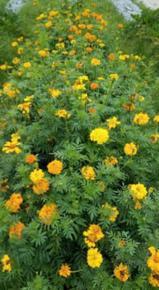Mar 6, 2019Look to a trap crop-cover crop mix as an IPM strategy
Vegetable farmers looking to curtail pesticide use may find alternative pest management strategies in the form of a trap crop/cover crop mix.


Through a Southern Sustainable Agriculture Research & Education (SSARE) Graduate Student Grant, University of Florida researchers studied the application of African Marigold (Tagetes erecta) and cowpea (Vigna unguiculata) for Integrated Pest Management (IPM) of sweet-potato whiteflies, aphids, thrips and root-knot nematode in squash production. They found that both African Marigold and cowpea hosted predatory species and parasitoids, including carabid beetles, lady beetles, and minute pirate bugs, in addition to suppressing nematode populations with the assistance of a resistant cowpea variety, a bacterial biocontrol agent applied to squash seeds, and the alleopathic effects of Marigold roots.
“We aimed to generate a cost-effective pest management program available to farmers against insect pests and nematode populations in squash production,” said Oscar Liburd, the principal investigator of the study (GS15-145), “Sustainable Management Strategies for Management of Key insect and Nematode Pests in Squash Cropping Systems.” Lorena Lopez was the graduate student on the project.
“The incorporation of this strategy in a squash cropping system can potentially translate into lower costs of production, higher production quality, and higher profits for growers,” said Liburd.
Of the insects collected over the two-year study in the trial plots, parasitoids accounted for 36 percent of the species, predators 20 percent, and plant feeders 34 percent. Only six pests of concern were identified, including melon and cowpea aphids, sweet-potato whiteflies, thrips and melonworms.
Researchers found that while cowpea hosted significantly higher numbers of predator and parasitoid species than marigold, the tropical legume also harbored a high number of aphids. Aphids are notorious for transmitting a number of diseases, including zucchini yellow mosaic virus, cucumber mosaic virus, and watermelon mosaic virus.
“Cowpea aphids could become a reservoir for secondary infestations, and fungal and viral diseases in squash plants. As a result, the use of cowpea intercropped with squash is not recommended as a viable strategy for squash pest management,” said Liburd.
Marigold, on the other hand, was found to be effective in managing pests in the squash plants.
“When African Marigolds were present, movement of the natural enemy populations (namely minute pirate bugs and adult lady beetles) towards the squash was observed,” said Liburd. “The presence of Marigold could reduce pest population build up in squash and, thus, minimize the use of insecticides.”
In addition, the flowers could generate additional income for the grower, he said.
Liburd and Lopez have received another SSARE Graduate Student Grant (GS17-171), “Development of an Integrated Pest and Disease Management Program Utilizing Companion Plants and Inundative Biological Control for Organic Squash Production,” to study additional companion plant systems in cucurbit production. The researchers are specifically evaluating African Marigold and alyssum as companion plants in conjunction with the predatory mite Amblyseius swirskii Athias-Henriot.
– Candace Pollock-Moore, University of Georgia














